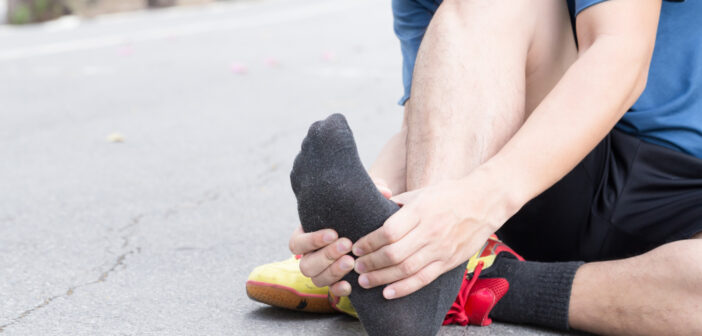Have you ever had a nagging pain in the bottom of your foot? It plagues you in the morning and feels like a dagger stabbing you in your heel with every step you take. If this sounds familiar, you could be suffering from plantar fasciitis.
Plantar fasciitis is inflammation of the ligament (plantar fascial band) that runs from the bottom of the heel to the forefoot and supports the arch. It is a very common foot ailment – flare-ups are commonly caused by an increase in activity or exercise involving repetitive impact. It is very prevalent amongst runners, especially during training season. The condition can also be exacerbated by walking barefoot, especially on hard floors. Pain associated with plantar fasciitis usually begins as a dull ache in the bottom of the heel but can progress to a sharp stabbing pain as the inflammation worsens. The pain is usually worse in the morning or after long periods of rest. That’s because the ligament is relaxed while resting and when you take that first step, it stretches the ligament, creating pain at its origin in your heel.
The good news is that 90% of people with plantar fasciitis are cured with conservative treatment. The most effective treatment is simply stretching the ligament. In fact, the majority of people do extremely well with just stretching, alone. One example: lean into a wall with your hands out in front of you, put the affected leg back behind you with your heel on the floor, and hold 10-15 seconds. You can also sit with your leg extended, then pull back your big toe/ankle and hold it. Doing this a few times before getting out of bed in the morning will help “warm up” the area, so your first few steps aren’t as painful. Ten to 15 reps of the stretches mentioned are recommended 2-3 times daily. In addition to stretching, you may need to temporarily reduce activity to allow the inflammation to subside.
Orthotics can help take some of the stress and strain off of the plantar fascial band, by adding support and cushion to the arch. This will help reduce your pain. Other common treatment methods include rolling your foot on a frozen water bottle, and icing it twice a day for 10-15 minutes (especially after being active) can help with inflammation. Depending on the severity of your pain and inflammation, your podiatrist may also recommend a corticosteroid injection to the area. Other treatments include over-the-counter non-steroidal anti-inflammatory (NSAID) medications like ibuprofen, physical therapy, or even wearing a night splint.
There are a few things you can do to prevent plantar fasciitis and subsequent flare-ups.
Do not go barefoot, especially on hard floors. Stretch your foot before exercising. Make sure your shoes are in good condition with ample cushion. Shoes that are too worn or broken down will not be supportive enough and can predispose you to plantar fasciitis. As a general rule, runners should replace their shoes about every 300-500 miles or every six months. Wearing orthotics helps support the arch.
If all else fails, your foot doctor is able to help you cure plantar fasciitis. They will get you on the right track for treatment and help you take the first step toward a less painful foot and training season.
The good news is that 90% of people with plantar fasciitis are cured with conservative treatment.
comzeal / stock.adobe.com


















